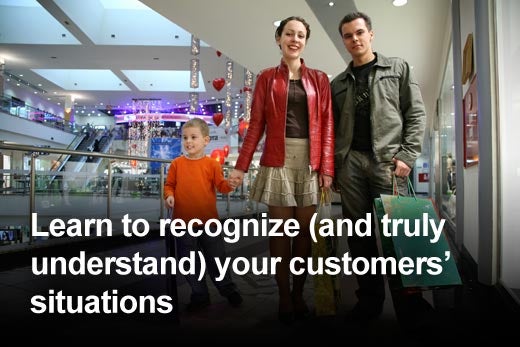It’s that special season again: the season of crowded stores, whiny kids, irritable customers, and stressed-out employees. If you’re a business owner—in any industry but especially in the retail segment—the holidays are a precarious time. When fuses are short and wallets are shrinking, customers expect great service, says author Maribeth Kuzmeski. Fail to provide it, or fail to instantly implement a recovery plan on those occasions when you do drop the ball, and you may find yourself experiencing a not-so-merry 2011.
“Every business owner knows things will go wrong from time to time,” says Maribeth Kuzmeski, author of the book …And the Clients Went Wild! How Savvy Professionals Win All the Business They Want and The Connectors: How the World’s Most Successful Businesspeople Build Relationships and Win Clients for Life. “It’s how you handle these episodes that counts. And at the holidays, the stakes are higher.
“People have higher expectations and a lower tolerance for mistakes,” she adds. “Combine that with distracted employees and larger-than-usual crowds, and it’s the perfect winter storm, so to speak. Without a good service recovery plan, you can easily lose the disgruntled customer, everyone she knows, and possibly a lot of people she doesn’t know if she takes her tale to cyberspace.”
According to Kuzmeski, many companies spend tons of money and time on big customer service initiatives in order to woo new customers—but they end up losing their regular customers over little things. When you consider the 80/20 rule—a maxim stating that most businesses get 80 percent of their revenue from 20 percent of their existing client base—it’s clear that you can’t afford to let that happen.
The solution, says Kuzmeski, is to a) stave off disasters by taking some commonsense preventive measures and b) develop some service recovery techniques and make sure everyone who interacts with your customers knows them. She offers the following advice:
Click through for 10 customer service tips from author Maribeth Kuzmeski, author of the book …And the Clients Went Wild! How Savvy Professionals Win All the Business They Want.
Provide an individual care approach for your customers. For example, someone shopping with children will have very different needs from, say, an elderly couple shopping for gifts for their grandkids. Therefore, you must train your customer service people to recognize these key differences and adjust their responses accordingly.
“Teach service employees to understand the context of a situation and to sympathize with customers,” says Kuzmeski. “For example, they might give the kids something to keep them occupied so mom can focus on shopping. Meanwhile, the employees might keep a close eye on the elderly couple in case they need any extra help looking at a product on a high shelf. When your customer service people are attentive and proactive, often they can solve a problem before it becomes one.”
Don’t tell someone you will be with him in a moment if you know you will be helping a different customer for ten minutes. He’ll just stand around impatiently for a while, start to feel annoyed, and then leave—probably heading straight to a competitor’s store. Instead, go find a coworker to help him out. If you know that he’s going to be waiting for a while, be honest about this. (It wouldn’t hurt to offer him a magazine to read while he waits.)
“Great customer service isn’t necessarily about getting it right every single time,” says Kuzmeski. “I think most people understand that occasionally even the best companies are going to fall short. But what your customers absolutely do have to see from you is that you are doing your level best to deliver on everything you’ve promised them.”
When handling a service issue, let the customer know what is going to happen and when it is going to happen. The more information a customer has, the less anxious she feels.
“While hearing that someone is going to address a problem is nice, hearing exactly how it will be solved is more comforting,” says Kuzmeski. “Let’s say you have an online store that sells handmade candles and you accidentally ship the wrong order to a woman who plans to give them out at her annual holiday party. Yes, you should assure her that you’ll correct the mistake right away—but you should also let her know exactly when her candles will arrive and assure her that you’ll pay for the rush delivery.
“When people know the specifics, they feel more in control of the problem and are more willing to partner with you on solutions,” she adds. “On the other hand, if you’re vague about timelines and end up interfering with the customer’s holiday plans or even making her worry needlessly — well, do you think she will ever order from you again?”
In the hustle and bustle of the holidays, it is all too easy to get caught up in your own stress, the million things you have to do for your business, and the other million things you have to do for your family.
“If this stress gets the best of you and you don’t handle a client properly, immediately reach out and make it right,” advises Kuzmeski. “Even the simplest of gestures can be effective: Offer an apology when you’ve made a mistake. Then, make things right by extending a peace offering. It doesn’t need to be anything extravagant. It can be as simple as a handwritten note, a refund, or a coupon.”
Make sure all employees (including temporary holiday help if you’re in the retail sector) understand the customer service plan and that everyone knows how to work together to solve customer problems. Creating standards, procedures, and methods of dealing with clients and servicing their needs can really help when it comes to resolving conflicts or handling a dissatisfied customer. You might even consider giving employees “key words” to use in tricky situations, says Kuzmeski.
“Sometimes people have good intentions but just don’t know what to say,” she adds. “It’s not unusual for a well-meaning employee to get flustered and say the wrong thing, which only exacerbates the situation. You don’t have to provide a rigid script—just a few phrases like ‘I’m so sorry this happened to you’ or ‘I would feel the same way if I were in your shoes’ can calm a customer down and salvage the relationship.”
It’s important to empower your employees to become connectors. Often, they might think offering a discount or a coupon is the right way to handle a situation, but they may be worried that you, their leader, won’t approve. Make sure employees know they can and should do exactly what it takes to keep the customer coming back—even if it costs the company or store a little in the short run.
“It’s better to give a customer a price break than to lose the hundreds of dollars he may spend with you in the future,” says Kuzmeski. “Express it to employees that way so they can truly understand it that way and make a smart decision.”
Have you ever considered how easy it is for employees to say “no” to customer requests? The truth is, saying “yes” usually creates more work for employees and forces them to take risks. And frankly, it seems that some service people don’t feel like they are being paid to say “yes.” It’s too much hard work. But what if employees were incentivized for “yes”? “Yes, I can do that for you over the phone right now.” “Yes, I can add that to your order.” “YES, I can do some hard work for you even though it would be easier for me to just say no.”
Admittedly, it may not be practical to rebuild your entire pay structure around incentiving yeses and penalizing nos, says Kuzmeski. But you can create a “culture of yes” in other ways.
“Why not occasionally ‘catch’ people saying yes to customer requests and reward them on the spot?” she suggests. “You might keep a stack of $10 gift cards on hand to give to yes-sayers, or perhaps send them home an hour early, with pay? It doesn’t have to cost a lot of money to reward people for creating happy customers—and your bang for the buck can be impressive, indeed.”
Think about it this way: If a customer has taken the time to call you about a service problem between the holiday parties he’s attending, his kids’ holiday plays, and so on, you are already getting lucky, so you’d better take care of it immediately. You don’t always get a chance to make it right. Often, customers will just move on. In fact, for each client who does complain, there are nine others who’ll just disappear without bothering to tell you why.
“Remember, your competition is constantly trying to sell the same product cheaper, faster, and better than you—especially during the holidays,” says Kuzmeski. “Don’t make it any easier for them by providing inadequate customer service.”
The stronger your brand, the more credible and visible you are and the easier it becomes for others to do business with you. Impactful contact with customers leads to confidence and trust. It differentiates you from competitors, makes your clients feel important, gives them something to talk about, and brings in the referrals you deserve.
“If you take a bad experience and turn it into a great one—by comping the customer’s order or perhaps giving her a gift card to a local restaurant—she will talk about it,” says Kuzmeski. “Obviously, that’s a far better alternative than having her out griping to everyone about how your company did her wrong and how she’s never doing business with you again.”
Obviously, you don’t have to sit around, anxiously wondering when a problem is going to arise. There is a way for you to avoid some (unfortunately, not all!) client conflicts. You can do it by ensuring that customers aren’t suppressing problems. And you do that by constantly asking for feedback. It’s amazing how rarely businesspeople do this, says Kuzmeski: They’re usually just keeping their fingers crossed that all is well. But a sincere inquiry about a client’s satisfaction is a true pathway to making a connection.
“Don’t be afraid to engage your clients,” says Kuzmeski. “Ask them what you can do better, how you can improve. Supply them with feedback surveys so that they can anonymously share their thoughts, ensuring that they are as honest as possible. As an incentive around the holidays, you might want to offer a discount to any customer who is willing to fill out the survey. Asking for feedback is a great way for you to rectify any possible or growing problems before they become so great that they sour a client relationship.”













